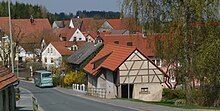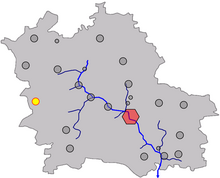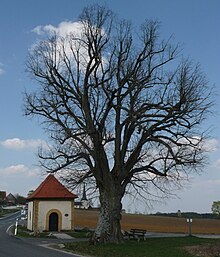Teuchatz
Teuchatz is a village in Franconian Switzerland and a district of the Heiligenstadt market in Upper Franconia in the Bamberg district .
Teuchatz has 221 inhabitants, is 545 m above sea level. NN and is therefore one of the highest-lying villages in the Bamberg district.
Village
The village is characterized by the predominant agriculture in Franconian Switzerland. In Teuchatz, too, the image of the village and the population changed due to changes in society and the fact that in 2005 a farmer was able to look after many more people than 100 years ago. (The ratio is around 80: 3, based on one hectare of land). In the 1960s there were only a few residents or families in the village who did not earn their living in agriculture. In 2005, however, there were only a few who farmed as their main occupation . Many of the farmers only run their business as a sideline and have another job as their main occupation.
Data from Teuchatz
- First documented mention: 1288 as "Tuchenze"
- First documented mention of the Church of St. James: 1430
church
After you have reached the Jura ascent from Zeegendorf at Teuchatzer Berg, the Roman Catholic St. James Church is at the entrance to the village. The complex with almost a meter thick churchyard walls gives the impression of being fortified. The massive choir tower is provided with slits and a spire from the 15th century. The nave was rebuilt in 1651 after the Thirty Years War.
A chapel already existed when Bishop Friedrich III. von Aufseß made Mistendorf a parish in 1430 . It is reported that “on July 13, 1430, at the request of the residents of the villages Mistendorf, Teugitz (Teuchatz), Zegendorf (Zeegendorf), Oberngrub, Drusenhofstatt, Neuses and Niedermistendorf, the two chapels that belonged to Our Lady in Mistendorf and that of St. Jacobi zu Teugitz (Teuchatz) together with the people of the seven villages separated from the parish of Buttenheim with the consent of Bishop Johann von Würzburg as the liege lord and the parish administrator Ullerich Aberhern zu Buttenheim and the chapel in Mistendorf to a new parish church of the seven Villages built because of the distant road from Buttenheim. The bishop reserves the right to award the new parish church ”. The founding document is in the Archbishop's Ordinariatsarchiv in Bamberg.
In times of war, such as the Meran inheritance dispute and the Hussite incursions, the fortified church was expanded as a refuge. The three church towers of Herzogenreuth , Hohenpölz and Teuchatz formed a fortress triangle and could communicate by means of flashing signals. A silver measuring chalice, a gift from the feudal lord Schaumburg, also dates from this period. Around 1630 Tiefenhöchstadt provided the curator.
Interior of the church
The first description of the interior is from 1682/83. A Catherine altar was named. In 1694 this altar was repainted by Elias Schmidt from Bamberg during an interior renovation for 36 florins .
In 1734 today's high altar was purchased. H. Meyer wrote in 1734: "100 bottles have been given to the master carpenter Walter in Bamberg in front of a new choir altar". The painting in the middle shows the patron saint James , to the side the apostles Simon Peter and John with a chalice. The earlier altarpiece with Saint Catherine was added to the side altar, for which Master Walter made a “cathedral”.
The two side altars were designed in 1874 by the Bamberg drawing professor Jakob Friedrich Schmitt († 1905). The left altar shows the Virgin Mary with Christ, the right one is consecrated to Saint Wendelin . A crucifixion group can be seen above the altars and a statue of Saint Sebastian is attached to the choir arch on the right .
The nave is characterized by stations of the cross, which are attached in pairs. These were donated to the church in Mistendorf in 1753 and consecrated on February 24, 1754 (documents from the Mistendorf parish). It is not known why they came to Teuchatz in 1785.
A statue of the Apostle James with the pilgrim's shell can be seen on a plinth above the entrance portal , carved and painted (painted) by Teuchatzerin Barbara Lunz. The James is mentioned in fortified churches and fortified churches in Upper Franconia by Edmund Zöller and Dieter Dietrich as a particularly beautiful statue. At the back of the church above the Karner ( ossuary ) there is a small Sacred Heart statue (also made by B. Lunz). An organ was first mentioned in 1763/1764:
- "5 fl are paid to the organ maker for the new little organ that the benefactors have made."
The organ did not last long, because in 1844 the pastor wrote to the regional court that there had been no organ for more than 30 years. One should agree to the submitted contract with the organ maker Berger from Bamberg. In 1846 the new organ with seven registers could finally be purchased for 260 florins .
A bell with the year 1634 survived the Thirty Years War, as early as 1667 a church tower clock was telling the Teuchatzern the time.
In 1814 the existence of the little church was in question. The reason was major structural damage. February 24th. the General Commissioner of the Obermainkreis wrote to the Bamberg Regional Court accordingly:
- “The branch church in Teuchatz collapsed in part in 1809. The inspection revealed that the church could no longer be made permanent in any way. The proposal was made (by Tiefenpölz) to tear down the church completely and to rebuild it. The cost is estimated at 1320 florins. It is to be discussed whether the church is not entirely dispensable. "
In the background was the difficult question of financing. The locals did not want to do without their church. Pastor Adam Söhnlein from Tiefenpölz answered that the church was indispensable because it was used by 460 believers in his parish. The way from Kalteneggolsfeld and Oberngrub to the mother church in Tiefenpölz is difficult in summer, but almost completely inaccessible in winter. The government ultimately approved the restoration.
On January 20, 1863, lightning struck the tower, pierced the ceiling in the choir in many places and shattered the western choir window.
In 1870 the rotten beams of the church tower were renewed. One was disappointed that the tower button did not contain any evidence of the history of the village or the church. Therefore this time a chronological tradition should be put into it for the future residents of the community Teuchatz , which has the following wording:
“Teuchatz, August 16, 1870
After completion of the repair work on the church tower helm, the largely rotten timbers of which had been thoroughly supplemented and partly reused, the button of the church tower could be put back on today after 3 months since the church tower was demolished. The funds were not sufficient to have the button gilded, as the carpentry and slate work resulted in costs of about FL 1000, which (with the exception of FL 150, which the royal government of Upper Franconia contributed to the church tower repairs on request) from the foundation, currently 7837 fl 10 kr capital owned, was paid and only the available funds were allowed to be used, but the subsidiary communities Teuchatz and Kalteneggolsfeld and Oberngrub did not pay anything to cover the costs of this repair of the church tower.
At the same time as the tower repair, the interior of the church was to be renovated, for which purpose the royal district government of Upper Franconia turned over 200 fl support from the Burk branch church foundation, which was far from sufficient, which is why the renovation was postponed for a long time but soon started will be taken. The church tower there was provided with 4 turrets on the sides in front of it, but which gave it a clumsy appearance and therefore remained away. In their place were 4 windows. Master carpenter Christian Herrmann von Buttenheim took over the carpentry work, master slate master Philipp Schrüfer von Bamberg took over the slate work on the local tower and carried it out to the satisfaction. Slayer journeyman Friedrich Köhsel from Plankenstein has shown himself to be particularly efficient in this work and has shown himself to be praiseworthy by removing the tower button and putting it on and by performing the most difficult and dangerous work of all.
During the re-erection of the tower beam, carpenter Johann Thumpert from Buttenheim, who deliberately wanted to descend on the outside of the beam, fell from the second floor and was dead.
At the same time as the tower here, the local hall chapel was also renovated. Mayor Dr. Schneider zu Bamberg paid the costs for this, as the chapel is an ornament of the city of Bamberg because of its panoramic view. Also in that year the parish hall, the construction of which caused much strife in the parish, was completed.
As further incidental circumstances, it should be worth mentioning that in 1866 a swarm of bees stayed in the local tower button for one summer, but it perished, as the remains in the button when the tower was laid have proven.
In the year 1863 on January 20th, lightning struck the local tower, pierced the ceiling in the choir in many places and shattered the western choir window completely. This case occurred simultaneously in the church towers in Mistendorf, Geisfeld, Amlingstadt and many other places. However, this is a case that has not yet occurred here, according to the oldest local residents. The year 1870, made famous by the Franco-Prussian War, will teach history to future generations.
The desire to learn even a little about the prehistory of the local community through a document kept in the tower knob, which was not found, prompted the undersigned to compose this document. Until it is read, those who read it today and saw it kept in the tower button will probably not hurt a tooth anymore.
Johann Dormisch, school teacher and church servant, also cantor and organist at the Roman Catholic. Branch church and school in Teuchatz. "
In 1990 this report was recovered and photocopied. Further time reports were found of the repairs carried out in 1933 under the era of Pastor Bierfelder. The tradition-conscious sacristan Alfred Schick keeps some copies of documents.
- Cemetery: The walled cemetery that surrounds the church has existed since the beginning of the 15th century.
- Karner (charnel house): Since around 1630 the people on the so-called mountains were all buried in Teuchatz, older graves had to be re-occupied for reasons of space. The skulls and bones were kept in the Karner.
- Field chapel on the outskirts
Outside the village towards the south there is a field chapel at the intersection between Buttenheim and Bamberg. It was built in 1734 to "sing" for the dead who were buried in the Teuchatz cemetery from the surrounding villages (Oberngrub, Tiefenhöchstadt, Kalteneggolsfeld, Hochstall and Kälberberg). The field chapel was built in 1743. It was last restored in 2001.
- Schoolhouse: The first schoolhouse was built in 1704.
- Torture on Teuchatzer Berg: The torture on Teuchatzer Berg is reminiscent of a girl murder in 1874.
- Torture with Saint James (made by Barbara Lunz) at the junction to the sports field
- Most of the Teuchatz family names have been known since 1326.
On May 1, 1978, the previously independent municipality of Teuchatz was incorporated into the Heiligenstadt market in Upper Franconia.
useful information
- Geological: fossils such as brachiopods, sea urchins, ammonites can be found in the fields.
- Flora: different types of orchids (forest birds, orchid), columbine, lady's slipper, speedwell
- Forest animals: deer, hare, mouflon and fox
- Stone Age finds from the Neolithic Age 2000 to 1500 BC Chr.
- In 1830 a violent storm raged, which overturned the measurement tower of the Bavarian land survey.
- Voluntary fire brigade: first motorized sprayer 1943
- 1956/57 New school building, also served as an agricultural vocational school
- 1965 Construction of the fire station
- 1968 first sports facility
- 1969 Hohe Marter Kreuz near the sports field, renovated in 1994. A woman froze to death there in a snow storm
- 1994 Consecration of the Jakobus-Marterls (former Mariengrotte) at the branch to the sports field.
- In 1994 the Voitsche Marter (Irish cross) was rebuilt in Geisberg. Pastor Voit had an accident there in a snow storm in 1688, but was rescued. Every year there is a pilgrimage to the cross.
- Up until 20 years ago there were two inns in Teuchatz.
population
The population is predominantly Catholic. The St. Jakobus Church is located in the village as a branch church of the Tiefenpölz parish .
location
The village lies in a small depression (545 meters above sea level) on the edge of the western mountain range of the Franconian Alb. On the outskirts, the terrain rises to 565 meters with the Veitsknock. Between the two villages of Teuchatz and Tiefenpölz, the Seigelstein rises at the same height as Teuchatz.
Neighboring places are Tiefenpölz , Lindach , Zeegendorf , Tiefenhöchstadt , Oberngrub , Burggrub and Oberleinleiter . Nearby cities are Bamberg, Forchheim , Ebermannstadt , Hollfeld and Scheßlitz .
A main triangular network point of the Bavarian land survey is located near the village . On a map from 1831 the point is labeled "Teichitz".
Life in the village
societies
There is still a strong community life in the village of Teuchatz. In addition to the sports club DJK Teuchatz, whose girls' team and the A-youth U19 became champions in their class in the 2007 season, the Teuchatz volunteer fire brigade in particular contributes to the community . The Teuchatz Oberngrub und Kalteneggolsfeld soldiers and comradeship association also helps shape village life through various activities. In various other initiatives, the locals always have the opportunity to meet roommates: trunk festival, curve festival, gas festival, oven festival . Another attraction is the St. John's bonfire , which takes place every year on the summer solstice around June 24th.
House baking
Home baking is now also being done again after it went out of fashion in the 1980s.
Easter fountain
The cleaning up of the Easter fountain is an expression of gratitude for the vital water in the karst region on the Jura . The village fountain is actually not a fountain at all, because the cut field stones hide a well room in which the seepage water is collected. The well house is therefore not fed by a spring. It was the only source of water for about 210 Teuchatzers until 1954. At that time the water was drawn into a butte (water barrel made of wood or sheet metal with two carrying straps), in which it was laboriously carried home. However, only the first water carriers were able to fill their containers during the dry season. The former village landlady extended the curfew in order to catch a full bucket during the night.
After heavy rains the water was inedible and often turned brown. Even in winter with frost or rapid snowmelt, the water supply was unsafe. This water was even said to have a certain healing power. It is reported that a Teuchatzerin had the well water brought to the Bamberg hospital because she was convinced that it would help her recover more quickly.
It became problematic when z. B. larger amounts of water were required for house slaughter. Then cows were harnessed and cleaned liquid manure tanks were used to fetch water from the next village (Burggrub). If necessary, you had to walk to the Zeegenbach spring below the Teuchatzer mountain. In Gries you scooped the water with cans in the containers. In 1954 the water problem was solved by building a water pipe.
Many legends tell of the tradition of the Easter fountain. Obviously the custom goes back to the Middle Ages and beyond. After that, in spring, maidens cleaned the fountains on the Jura plateau after the snow melted while singing and dancing. As a sign that the well had been cleaned, they crowned it with fresh green. In 1975 the old tradition was remembered in Teuchatz. Since then the Teuchatz women have been painting eggs in the pre-Easter period. However, this old custom is becoming increasingly kitsch for the sake of tourism.
tourism
The village is known for its cross-country skiing opportunities in winter. Due to the altitude, the snow is usually a little longer than in Bamberg, Forchheim or Erlangen. Most of the winter sports enthusiasts come from there. It was thanks to an initiative going back to the 1980s that cross-country ski trails could be drawn with the cross-country ski tracker when the snow conditions were good. If the snow conditions were good, there were around 30 to 40 kilometers of trails available. For a few years no cross-country trails have been groomed.
The wind turbines of the Oberngrub wind farm that have recently been set up in the direction of Oberngrub are discussed very controversially.
500 meters south of the village is the large linden tree near Teuchatz , which is said to have been planted on Swedish graves during the Thirty Years War .
Individual evidence
- ^ Federal Statistical Office (ed.): Historical municipality directory for the Federal Republic of Germany. Name, border and key number changes in municipalities, counties and administrative districts from May 27, 1970 to December 31, 1982 . W. Kohlhammer GmbH, Stuttgart and Mainz 1983, ISBN 3-17-003263-1 , p. 672 .
- ↑ Communication in Münchner Tagblatt No. 151 of June 30, 1830
- ^ Adrian v. Riedl: Main triangular network for the topographic atlas of the Kingdom of Bavaria , 1831, Bayerische Staatsbibliothek, Mapp. XI, 57ge, Munich
Web links
Coordinates: 49 ° 52 ' N , 11 ° 6' E







